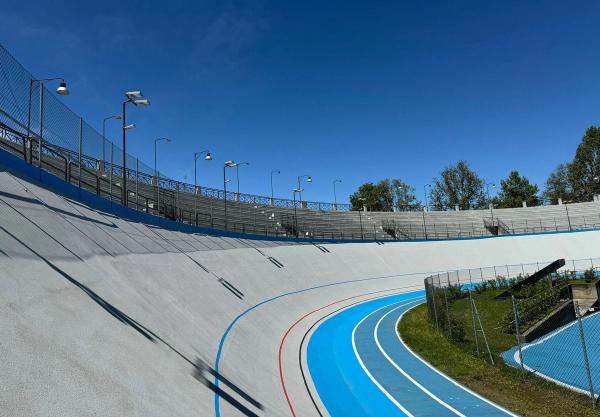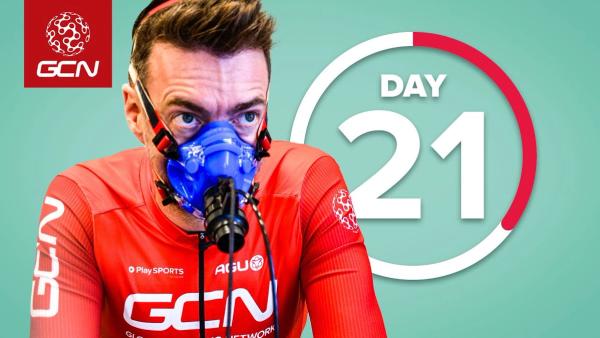Why do my knees hurt from cycling and how can I fix it?
Our comprehensive guide to knee pain, from the main types, to the best solutions.
James Howell-Jones
Junior Writer
Cycling is a low-impact sport, with research showing that less than half of our bodyweight goes through the pedals when seated. Nonetheless, most cyclists will experience knee pain at some point in their life. The good news is that whatever type of pain you have in your knee, there’s a very good chance that an improved bike position and a bit of conditioning will resolve it.
We spoke to physiotherapist and bike fitter Bryan McCullough from The Bike The Body to find out how cyclists can fix knee pain.
Read more
What causes knee pain?
As a rule, knee pain when cycling is caused by one of three things: an incorrect position on the bike, a lack of strength and conditioning, or a rapid increase in training load.
Will my knee pain get worse or go away with more cycling?
Whatever kind of knee pain you’ve got, know that gritting your teeth and riding through it won’t help. In fact, in most cases, it’ll make things worse, potentially turning a bit of inflammation into a real injury. If you have knee pain, rest up, and only return to cycling when it’s improved.
How to fix knee pain by checking your bike position
If you're getting knee pain while cycling, the first thing to do is to check your position on the bike is correct. Research shows a direct link between bike position and knee injury risk. For knee pain, there are two aspects of your bike fit that make a massive difference.
1. Saddle position

© GCN
Make sure your saddle height, setback and angle is correct
An incorrectly positioned saddle can cause knee pain. We've got a complete guide for setting your saddle height and position correctly, but it comes down to three things. Firstly, the height of your saddle. Secondly, the amount of setback on your saddle, and finally, the angle of your saddle. Getting each of those three things right takes a lot of fine-tuning, so have a look at Manon Lloyd's guide for saddle positioning to get everything spot on.
2. Pedals and cleats

© GCN
The position and type of cleat can have a big impact on your knees
Incorrectly set up pedals and cleats can cause knee pain too. Firstly, you need to make sure your cleats are correctly positioned. We've got a guide that should put them in exactly the right place, but simply put, the cleat should be under or behind the ball of your foot, and your feet should be pretty well straight on the pedals.
It's worth considering whether your cleats and pedals have the right amount of float, too. Float is the amount of movement the pedal allows the cleat to make while clipped in. Some cleats, like the ones used by some WorldTour sprinters, have no float at all. For most of us, that's going to be a sure-fire way of getting knee pain. To learn more, have a look at our video exploring whether pedal float can fix knee pain.
How to fix knee pain with strength and conditioning
If your bike fit is correct, it's possible that your knee pain is due to a lack of strength and conditioning. Cycling works a fairly narrow range of muscles in a fairly limited way, so it's easy for muscular imbalances to develop.
Usually, cyclists develop powerful quads, but weak glutes, the muscles in your backside. To tackle this, try strength training or cross-training. For knee pain, your glutes are a good place to start.
Expert physio Bryan McCullough suggests the following strength drills:
Using a resistance band, pull backwards with each leg in turn

© GCN
Pull against the band to work your glutes
The first strength drill to try requires a resistance band, essentially a large elastic band. Find a band that can fit reasonably snugly around both of your knees when you stand with your legs apart slightly.
From this position, and holding onto something for support, raise one leg off the ground and move it backwards and outwards, against the resistance of the band. After a few reps, switch to the other leg. Regularly doing this will work your glutes, which will help your knee stability on the bike.
Reverse lunge

© GCN
Reverse lunges require no equipment, and work the glutes
This one doesn't require any equipment. From standing, simply step back and into a deep lunge, keeping your weight over your front leg. With the back leg, bring your knee down to the ground in a controlled way, then using your front leg, come back up to a standing position. Again, this is going to work the glutes, and again, be sure to work on both legs.
For more strength and conditioning workouts, we've got a playlist of guided workouts for the core, glutes and other crucial muscle groups on the GCN Training channel.
How to fix knee pain by gradually increasing your training load
In many cases, knee pain is caused simply by increasing your training load too quickly. ‘Spring knee’, as it’s known, describes knee pain that arises when cyclists dig dusty bikes out of garages and start piling on the miles, which is usually in spring. Our legs aren’t used to it, and sure enough, our knees start to suffer. To avoid this, be sure to make any increase to your training load gradual. For more tips on building an effective training plan, see our guide.
How to fix knee pain with kinesio tape
For a quick fix, kinesio tape or KT tape can be used to push the patella into the correct position, but this addresses the symptom and not the cause. The underlying issue, whether that’s an incorrect bike fit or muscular imbalances, will still be present. While using tape is a good last resort, the only way to solve knee issues is by resolving your position and conditioning your body.
What are the most common types of knee pain for cyclists?
Pain under the kneecap
If your kneecap (or ‘patella’) hurts, you’re likely suffering from anterior knee pain. This is the most common type of cycling knee pain, and the pain itself comes from inflammation of the tendon that sits between your knee cap and your femur, the large bone in your thigh.
A sore knee cap is usually caused by one of two things.
In most cases, it’s caused by a muscular imbalance in the thigh, which causes the patella to be pulled to one side or the other. The motion of cycling strengthens and shortens the quads, and as they shorten, they tend to pull the leg outwards. Subsequently, some cyclists open their knees, and end up riding with their knees away from the bike, rather than directly over their pedals.
In some cases, it’s caused by an incorrect bike fit. If your saddle is too low or your crank arms too long, the angle at the top of the pedal stroke, when your knee is in its most ‘closed’ position, will be too tight. The patella will be pulled against the femur, stressing the cartilage behind the kneecap.
How to fix anterior knee pain
Ease into new training plans
Anterior knee pain is usually caused by a lack of conditioning. If you’re trying to increase your mileage, do so gradually. Focus on developing a good pedalling technique first, then, add intensity to your riding.
Pedal at a higher cadence
Pushing a heavy gear or pedalling at a low cadence will increase the stress on your quads and your patella. Instead, use an easier gear and ride at a higher cadence.
Stretch your thighs and buttocks
In most cases, anterior knee pain stems from muscle imbalances. Stretch the outside of your thigh to add length to your quads and your IT band to prevent your knees from straying outwards.
Strengthen your legs
Cycling doesn’t work on all the muscles in your thighs evenly. Strengthening your glutes with squats and glute bridges can help give you a more balanced composition.
Check your saddle height
Check your saddle height is right using our guide to setting your saddle height.
Check your crank length
Calculating the angle of your knee at the top of the pedal stroke is tricky at home, and a professional bike fitter will be able to find a definitive answer to this. Generally speaking, though, if you feel your knee has to pass through an extremely tight angle to get around a pedal stroke, your cranks might be too long.
Pain in back of the knee
If the back of your knee hurts, you’re suffering from posterior knee pain. In almost all cases, this is caused by over-extending the leg, which is often down to the saddle being too high or too far back.
Check your saddle height
Check our guide to finding the perfect saddle height and make sure yours is right.
Stretch
If your saddle is in the right position and the back of your knee still hurts, you might need to work on your flexibility. Stretch the back of your legs regularly, especially after riding.
Pain in the inside of the knee
If the inside of your knees hurts, you’re suffering from medial knee pain. In most cases, this is caused by the position of your feet, but it can also be caused by an incorrect saddle height. Some studies suggest that this is linked to larger knee adduction, or a larger lateral movement in the knees.
Pain in the outside of the knee
If the outside of your knees hurts, you’re suffering from lateral knee pain. As with medial knee pain, in most cases, this is caused by the position of your feet, but it can also be caused by an incorrect saddle height. Some studies suggest that this too is linked to larger knee adduction, or a larger lateral movement in the knees.
How to prevent pain on the inside or outside of the knee
If your feet are incorrectly positioned, that can cause knee pain. Make sure your cleats are set up right, with the right amount of float. Then, there’s the matter of your shoes and ankle pronation. Some shoes will be completely flat, while others will provide more arch support. Depending on how strong the arches of your foot are, that can affect the angle of your foot, and the engagement of your knees.
In summary
Knee pain is really common among cyclists, but in most cases, it’s something you can resolve. First of all, make sure that you increase your training load gradually, especially during spring, when most of us come out of hibernation and start riding as the weather improves. If you’re being sensible with your training load, and knee pain is still an issue, in most cases, you either need to resolve bike fit issues, or do some strength and conditioning. You might even need to do both.
The most important thing to remember, though, is that knee pain doesn’t go away if you try and push through it. In fact, it’s likely to make it worse. So be sure to take any knee pain seriously, and resolve the issue rather than soldiering on.










